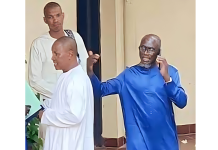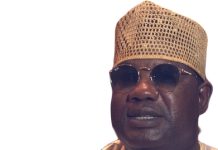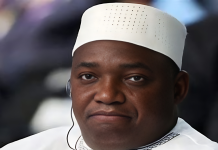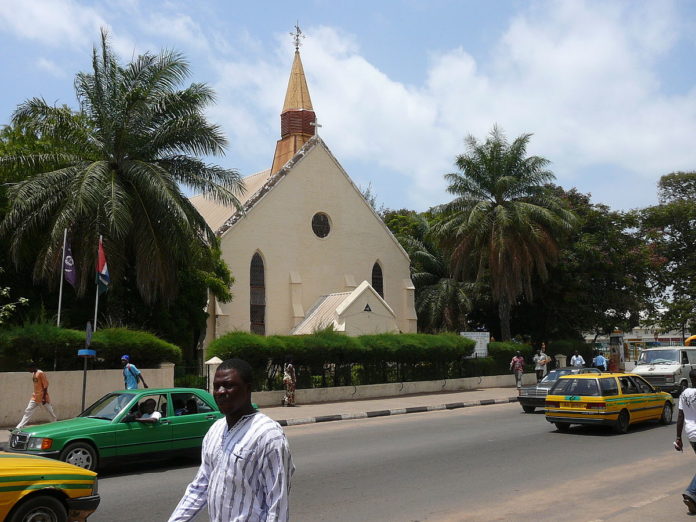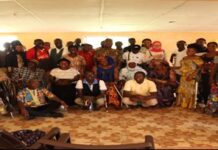Prof Pierre Gomez
Associate Professor of Comparative Literature
Dean, School of Arts and Sciences
The University of The Gambia
Brikama Campus, P.O. BOX: 3530
The Gambia
West Africa
Challenges of Gambian Churches During Yahya Jammeh’s Erais a 224 page assorted narrative by Mr Philip Saine. It is divided into twenty-eight chapters. The narrative is told in prose style and occasional lacing with photographs. Sometimes the author uses the epistolary style using blueprints or scanned copies of correspondences and petitions adding credibility to his claims. The work chronicles the challenges that in the past have threatened the Christian community in the Gambia, beginning with the former President’s declaration of an Islamic state in December, 2015; the role played by the Christian community both home and abroad to avert the challenges; and how (through prayers) the church prevailed in the end.
In this work, what the author tries to do throughout is to assume the role of a witness and spokesperson for the church who has not been a passive spectator during the struggle but one who kept record of events and interprets them for future generations.
At this point, the question that requires answering is “why the need to write Challenges of Gambian Churches During Yahya Jammeh’s Era? As if anticipating this question, Mr Saine has answered it very early in his work:
“The primary reason for writing this book, therefore, is to help present to both the present and future generations of Gambians with a document which recollects the notable events which took place within a period of two years (2015-2017), as accurately as possible. Given the grave degree of culpability exhibited by several ministers and officers within and without the government of the second republic, my second reason is to point out errors of judgment and a reminder that the very first clause of the 1997 Constitution of The Gambia to which we are all enjoined stated that “The Gambia is a Sovereign Secular Republic” [1997 Constitution, Cap 1. (1)]”.
In chapters one and two, he presents the greatest threat that the domestic church has encountered, citing that on 10thDecember 2015, former President Yahya Jammeh in Brufut made a declaration that The Gambia would be an Islamic State.
“As from today, The Gambia is an Islamic Republic noting that the majority of Gambians are Muslims. Accepting Islamic religion as your religion and as a way of life is not negotiable. We will respect the rights of all citizens. This does not mean that the Christians cannot practise their religion. You the Muslims, worship according to the Quran and the Sunna of the Prophet of Islam (PBUH) and let the Christians worship the way they do. I am not appointing any Islamic policeman…”
This threat was heightened when The Gambia Supreme Islamic Council (GSIC) made a solidarity visit to the president in support of the statement. In addition, the president tasked government to work for legislation to be placed before the National Assembly.
Chapter three of the book looks at the reaction of the Knights of Saint Peter and Paul- The Gambia. It reveals that the Knights resolve to challenge the declaration by instituting a task force that informed parishioners about the declaration and writing to the Office of the President for clarification which indeed did come stating “The declaration was very clear and final”.
The text has expressed concern that this may serve as a wedge that hinders the high degree of religious tolerance, respect and social integration enjoyed in the Gambia, which the writer claims has its roots in Christian mission schools. With the declaration, it is feared that foreign “well-meaning” fanatics who, especially with the backing of the law, could corrupt and weaken the fabric of tolerance and integration that holds our society together, leaving us in misery and despair.
The reaction to challenge the declaration was not only from the Christian community in the Gambia but also from The Gambian Peoples’ Christian Association of Metropolitan Washington, D.C. (GCPA-DC). In a letter addressed to the Gambia Ambassador to the US, Sheikh Omar Faye, the GCPA-DC reiterated its open condemnation of the declaration describing it as un-Gambian and a dishonest means of instilling discord in our society using the religious divide.
Perhaps it should whet your interest to learn that the author has included a chapter (chapter 4) on The Gambia Supreme Islamic Council Conference on the Declaration and what transpired during the conference. It contains first-hand account of the purpose of the conference, topics, presentation and speakers, and observations made. However, the book went further to also discuss the position of some eminent Muslims who expressed their total condemnation for the declaration both within and outside the Gambia. This shows that the majority of Gambian Muslims were not in support of the Brufut declaration. They strongly believe in One Gambia, One people, One nation.
In chapter 5 entitled Dr. Zakir Naik: Rev. Fr. Edu: Divergent Sermons (Kang Kiling), the author further featured prominent personalities from the church and their outspokenness against the declaration.
In addition to Chapter 6 on the media circulated paper by Matthew K. Jallow, chapter 7 looks at how the Diocese of Banjul took up a daily prayer in respect of the challenges facing the domestic church. It treats the bold move taken by The Gambia Christian Council in organizing the 1st, 2nd and 3rd Editions of National Days of Prayer and Service. The author highlights the success of the events in that they have unified the Christian community in its strife for a common cause. In his own words, the author claims:
The Christian Day of Prayer and Service in The Gambia went well and far beyond expectations. It would be recorded as a great day of Christian unity and solidarity in the history of The Gambia.
In chapter eight, the author highlights the challenges faced by the Christian community during Divine Mercy Sunday – April 2016. The author argues that during the event, tradition was twisted when three scenes happened,
- Interception by uniformed Officers along Independence Drive for questioning about permit
- Interception at Arch 22nd (ie. passage under the Arch was normally denied to vehicles except the Presidential convoy and funeral vehicles).
- Incidence along Kairaba Avenue involving a driver who insisted on driving through the crowd
The author observed that these incidents are signs of religious tensions and manifestations of intolerance which have heightened the concern of the church for its existence and future in the new Islamic republic. Thus he makes some recommendations.
- That organizers of similar religious processions should always endeavour to apply for a permit from the Inspector General of Police.
- That organizers of similar religious processions must also get uniformed officers to escort the procession.
In Chapter nine, Mr Saine adds the role the church played in preaching the doctrine of love in the ‘Love Each Other’ – Sermon by Reverend Gabriel Leonard Allen on April 24, 2016. The sermon was made to, as Mr Saine puts it, “revisit our history to discover love in action”.
During the sermon, some thought-provoking stories were shared like the abolition of slavery and the founding of Banjul with authoritative reference to authors like Patience Sonko Godwin and Florence Mahoney whose names are household names in Gambian history. Mr Saine also cites the story of our lord Jesus Christ for paying the ultimate price for our sins.
On the Cross, Jesus offered blanket forgiveness to all who had hurt him: “Father, forgive them for they know not what they do” [Luke 23:34]. In our interpretation, this forgiveness included his Betrayer—Judas Iscariot, who eventually committed suicide. By this act, Jesus demonstrated how we are to love our Betrayers.
Chapters ten and eleven discuss the first and second visits of Apostolic Nuncio Most Reverend Miroslaw Adamczyk in May and August 2016. This chapter contains itineraries, meeting proceedings, reports, and resolutions passed during his two visits.
The chapters twelve and thirteen bring into the discussion matters threatening the existence and continuity of the church. These include a ban on drumming and dancing etc. during Ramadan, the reaction of the Christian community to the press release and the clarification from the office of the president. This challenge is also experienced in the stand-off over the Banjul Christian Cemetery which is perceived as an attempt to test the complacency of the church in serving as proxies to his high level deception and dictatorial rule. The author goes further to report how the Christian community refused the former president’s donation of twenty-nine cattle as a show of its resolve to depoliticize the church.
Perhaps it will whet your interest to note that the book also contains, in the chapters that follow, an in-depth report on the role of the church in working for change of presidency regaining its status in the Gambia. The chapters include The Diocese of Banjul’s Position as Regards the 2016 Presidential Election; Our Choice of Presidential Candidate; Report on the Presidential Election –December 1st 2016 (before, during and after election). This is clearly highlighted in chapter twenty three where Presiding Bishop Hannah Caroline Faal-Heim of the Methodist Church, carrying her cross and filled with the Holy Spirit decided not to bow before any human being but God. During the famous State House high level religious meeting, Bishop Faal-Heim, with confidence, spoke truth to power.
These chapters present the position of the Church and its congregation. With first-hand accuracy, the author reveals the Church’s unanimous support for the Opposition Coalition Candidate, Adama Barrow and its total rejection of Jammeh. The author goes further to highlight the Consequences of Jammeh’s Refusal to Abide by ECOWAS, AU, and UN Dictate in chapter twenty four. This was followed by a chapter on the inauguration of President Barrow in chapter twenty-five and his appointment of some Christians in different ministries such as Basic and Secondary Education, Fisheries, Water Resources and National Assembly Matters, and Youth and Sports which has restored the confidence of the Church to once again regain its dignity and status.
Summarily, even whereas Article Twenty-Five of the 1997 Constitution of the Republic of the Gambia protects the rights of citizens to practise any religion that they may choose, Jammeh’s December 2015 declaration of The Gambia as an Islamic State, which he described as final and irreversible, plunges the Christian community into a great cloud of hovering anxiety. However, like the saying that “every cloud has a silver lining”, the December declaration challenged and strengthened the faith of minority groups. It re-ignited efforts to reunite.
The youths of our Churches have been more than worth examples of courage during those periods of so much uncertainty. Now with Jammeh gone, bringing an end to his declaration, the Church has become stronger and more united than before. Praise the Lord!
As I conclude this review, for conclude I must, I wish to say that Mr Philip Saine has not only succeeded in his ecclesiastical duties but has also helped in preserving Gambian history. Generations to come shall view this work and revel for the great work that those before them had done. Morally, the work teaches honesty, steadfastness, resilience, peace and unity in the face of distress.
I urge you all to grab a copy, be enlightened and protect your copy to be passed on as a rich legacy for generations yet unborn.

